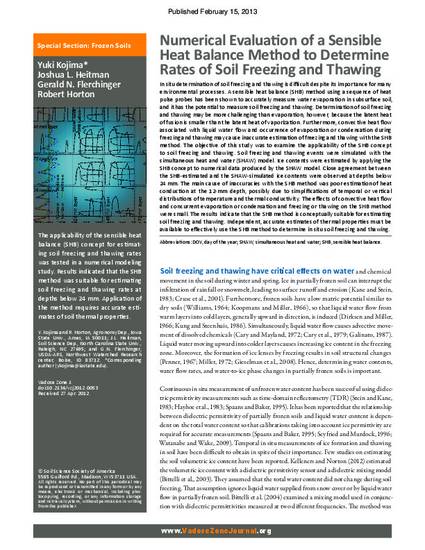
The applicability of the sensible heat balance (SHB) concept for estimating soil freezing and thawing rates was tested in a numerical modeling study. Results indicated that the SHB method was suitable for estimating soil freezing and thawing rates at depths below 24 mm. Application of the method requires accurate estimates of soil thermal properties. Agronomy Dep., Iowa State Univ., Ames, IA 50011; Soil Science Dep., North Carolina State Univ., Raleigh, NC 27695 USDA-ARS, Northwest Watershed Research center, Boise, ID 83712
In situ determination of soil freezing and thawing is difficult despite its importance for many environmental processes. A sensible heat balance (SHB) method using a sequence of heat pulse probes has been shown to accurately measure water evaporation in subsurface soil, and it has the potential to measure soil freezing and thawing. Determination of soil freezing and thawing may be more challenging than evaporation, however, because the latent heat of fusion is smaller than the latent heat of vaporization. Furthermore, convective heat flow associated with liquid water flow and occurrence of evaporation or condensation during freezing and thawing may cause inaccurate estimation of freezing and thawing with the SHB method. The objective of this study was to examine the applicability of the SHB concept to soil freezing and thawing. Soil freezing and thawing events were simulated with the simultaneous heat and water (SHAW) model. Ice contents were estimated by applying the SHB concept to numerical data produced by the SHAW model. Close agreement between the SHB-estimated and the SHAW-simulated ice contents were observed at depths below 24 mm. The main cause of inaccuracies with the SHB method was poor estimation of heat conduction at the 12-mm depth, possibly due to simplifications of temporal or vertical distributions of temperature and thermal conductivity. The effects of convective heat flow and concurrent evaporation or condensation and freezing or thawing on the SHB method were small. The results indicate that the SHB method is conceptually suitable for estimating soil freezing and thawing. Independent, accurate estimates of thermal properties must be available to effectively use the SHB method to determine in situ soil freezing and thawing.
Available at: http://works.bepress.com/robert-horton/66/

This article is published as Kojima, Yuki, Joshua L. Heitman, Gerald N. Flerchinger, and Robert Horton. "Numerical evaluation of a sensible heat balance method to determine rates of soil freezing and thawing." Vadose Zone Journal 12, no. 1 (2013). doi: 10.2136/vzj2012.0053. Posted with permission.